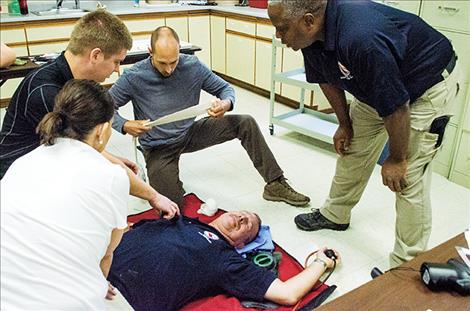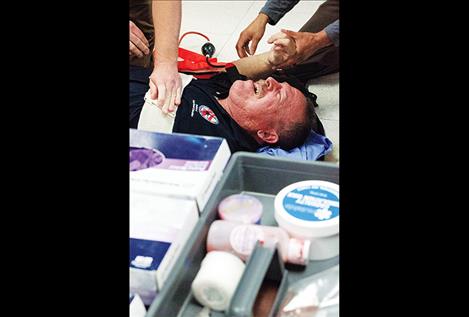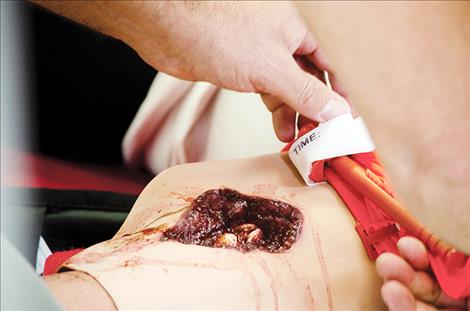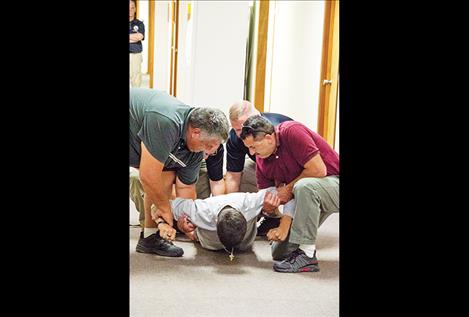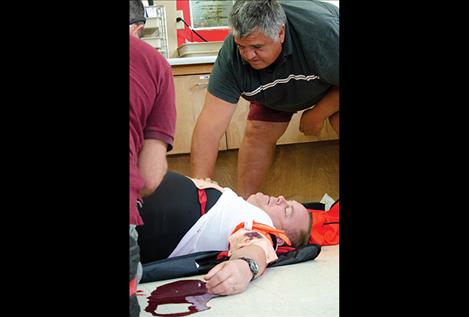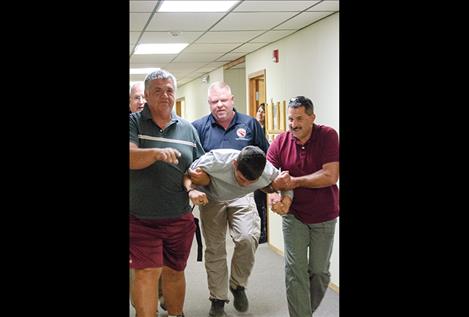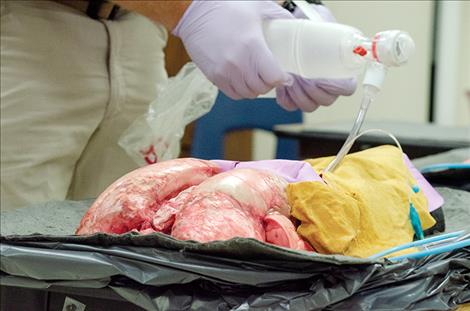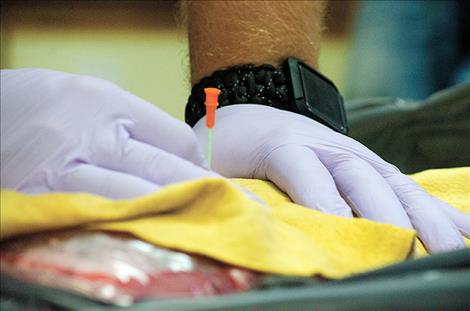Police, fire, medical teams train to become unified team
Hey savvy news reader! Thanks for choosing local.
You are now reading
1 of 3 free articles.
PABLO – The situation wasn’t real on Wednesday when a man spread out on the floor with three gunshot wounds in a classroom at the Salish Kootenai College, but an emergency team responded to the scene as if it was really happening.
The three-day training exercise was a bit different than usual. Police officers, fire crews, medical teams and other departments were working as one unit to respond to the scene. Usually, they train separately, but if a shooting happens, they need to work together to save lives.
The training instructors dressed their mock victim with blood and bullet wounds to help make the scene look realistic. The victim called out for help as the team assessed the situation and used gauze to try and stop the bleeding.
Louisiana State University’s National Center for Biomedical Research and Training worked with the Confederated Salish and Kootenai Tribes and SKC to provide the active shooter training along with the State of Montana’s Department of Emergency Service. NCBRT provides training to emergency responders throughout the United States under the Homeland Security National Training Program.
One hundred and sixty people from all over Montana including local departments and a few from out of state registered to participate in the event with funding from a federal grant for what was called a “world class training program” with support from highly trained individuals.
SKC provided the venue for the training and worked with the NCBRT to create the curriculum for the mock shooting situations. Federal Emergency Management Agency representatives also attended.
The Polson Police Department thanked the SKC Emergency Services Academy for hosting the “excellent” active threat intervention symposium. They noted that collaborative efforts of school officials, law enforcement, healthcare providers, fire personnel, and emergency managers all function as one unified team to help create the best possible outcome in any active threat.
Jerry Flood, one of the NCBRT instructors, is a retired police officer from the New York Police Department. He said joint training exercises are being pushed nationally to help save lives in mass casualty situations.
Flood said numerous active shooter situations from the high school in Florida to the concert in Las Vegas have taught officials that emergency medical responders, fire crews, police and other departments need to work together to respond to a scene to help people.
Greg Gould, SKC Emergency Services Academy director, organized the event. He worked on emergency medical teams before becoming the director. He said active shooter protocol in the past was developed around securing the scene. “We needed a plan to help get to people much faster.” He said when police, fire and medical personnel work together, they can organize teams to go in and help victims when the scene is safe.
“In the past, we had a pattern where cops were really good at their jobs, but the EMTs were left out of the situation,” he said. “They would be waiting in the parking lot while people were bleeding out. We’ve learned that the teams need to work together to be faster and more efficient. The mantra is that the cops stop the killing and the paramedics stop the dying, and they create a partnership to do it together.”
The three-day event brought law enforcement, health providers and emergency managers together to practice coordinating responses.
“Active threats create a dynamic that are like a natural disaster where we need people to inform the media, coordinate more ambulance services and other things that are typical to disasters,” he said.
Besides helping the victim of a mock shooting, participants were shown how to help a victim with a collapsed lung. A pig lung was used to show how to properly inflate the lungs.
At another station, an instructor was demonstrating how to get fluids into a patient when they are in shock. The procedure involves drilling into the bone to run an intravenous needle into the body. The ribs from a pig were also used to show how to save someone when air is building up in the lungs after they’ve been shot in the chest.
During the training, Ravalli County Sheriff’s Sgt. Jake Auch waited outside the room as the victim for the active shooting exercise was getting ready.
“As a cop, I’ve learned a lot here about medical procedures,” he said. “I’ve done training courses before, but not anything with this much medical. It’s good to know how to do this and how to work with the medical responders.”
An announcement was made that the room was secure. Auch quickly moved in beside the emergency medical crew and started helping the victim. He grabbed a role of gauze and asked how he could help. Polson Police Sgt. George Simpson was with the next team working to save the victim.















